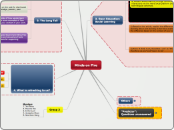Protecting
Social
peer groups, community, school, and ethnic factors.
Family
Events and reltionships within family/extended family.
Biological
Systems of body
Innate characteristics
Temperment
Health
Physical development
Psychological
Personality characteristics
Coping mechanisms
Emotional/Cognitive development
Mental Health
Bio-Psycho-Social Framework
Offers a NO blame theory
Mental Illness runs in families
Present
Perpetuating
Onset
Precipitating
Birth
Predisposing
Who?
Affects families
youth
women
Community focused
not all uniform
What is it?
Subtopic
Economic impact is great
M.I. and physical healh occur together
Altered thinking mood behaviour
Duration and intesity
Multiaxial Assessment
Axis 5: Global assessment of Functioning
Axis 4: Psychosocial & environmental problems
Axis 3 General medical Conditions
Axis 2 Personality Disorders
Personality
Axis 1: Clinical disorders
Severe
Anxiety
Specific
Generalized
Mood
Psychoic
Social work and the DSM
Perspective
reflects don't Negate DSM either
Categories are social constructions
Diagnosis not truth that resides within ppl
intersubjectivity of human expression
Subjective or objective reality
Empower or disempower
Con
dimentional/contextual assessment better
not useful in treatment plan
Labeling
obscures individual differences
Pathologize social norms (Subservient women)
Ignores strengths
Disease model of emotional distress
pathologize behaviour (more power to proffessional)
Dependence on category (if no fit no problem)
No adress to concerns of social workers
Ignores social aspect (axis IV helps)
assumes universal categories
Just descriptions
Pro
Use in non-clinical (awareness/screening)
Collective knowledge on problem
Assessment more efficient
Common language
Organizes information
Reliability of DSM 4
Bi polar .84
Depression 64
Schizophrenia 65
Alcohol abuse 75
panic disorder 58
Social phobia 47
Anorexia 75
Over 70 is good reliability
Validity
Measures what is suppose to be measured
Reliability
Consistent over many tests
Diagnostic & statistical Manual of Mental Disorders DSM IVRT
Beginning of evidence based practice
Created by Kraeplin in 19th C
Spitzer changed to a checklist of symptoms
Doctors all use same checklist
Goal:increase Validity
Ab/Normal
Level of functioning
Psych Handicap
Social deviance
Intensity of pain
Subjective distress
Duration/persistence
Context
Cultural
Appendix now has Cultural variations
Stima in other countries is great
Somatic complaints (sick in heart) not in emotive words
Latinos Dep.= headaches
Guilt NOT a large part of Dep. in japan, Iran
Global appearance but also looks different









